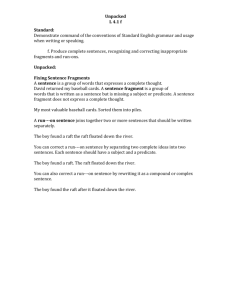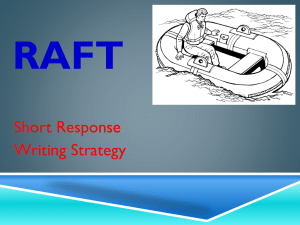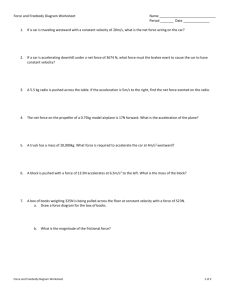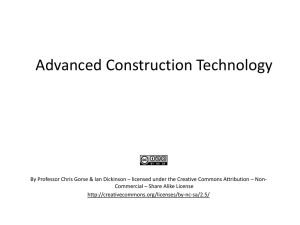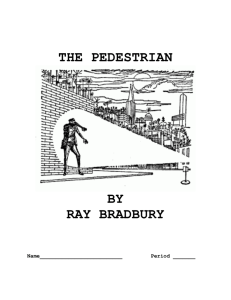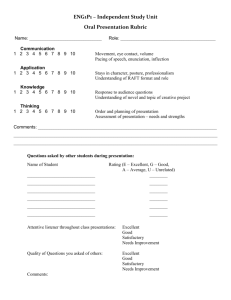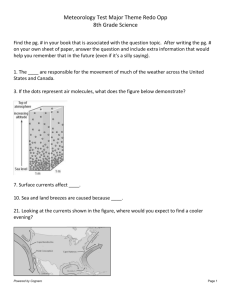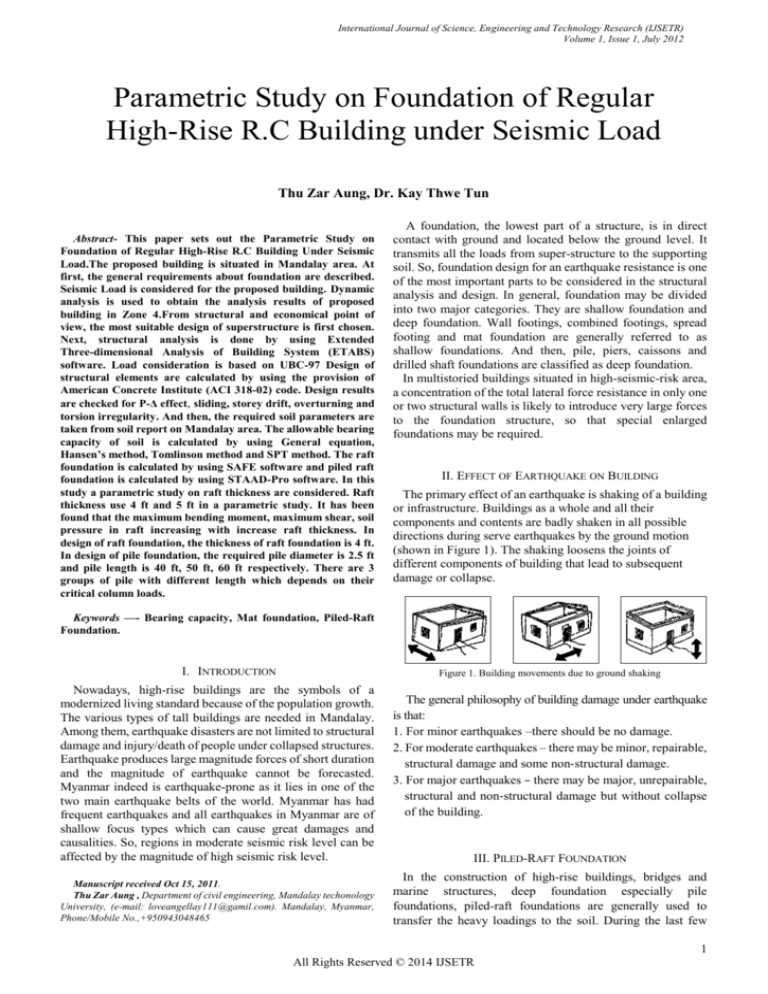
International Journal of Science, Engineering and Technology Research (IJSETR)
Volume 1, Issue 1, July 2012
Parametric Study on Foundation of Regular
High-Rise R.C Building under Seismic Load
Thu Zar Aung, Dr. Kay Thwe Tun
Abstract- This paper sets out the Parametric Study on
Foundation of Regular High-Rise R.C Building Under Seismic
Load.The proposed building is situated in Mandalay area. At
first, the general requirements about foundation are described.
Seismic Load is considered for the proposed building. Dynamic
analysis is used to obtain the analysis results of proposed
building in Zone 4.From structural and economical point of
view, the most suitable design of superstructure is first chosen.
Next, structural analysis is done by using Extended
Three-dimensional Analysis of Building System (ETABS)
software. Load consideration is based on UBC-97 Design of
structural elements are calculated by using the provision of
American Concrete Institute (ACI 318-02) code. Design results
are checked for P-Δ effect, sliding, storey drift, overturning and
torsion irregularity. And then, the required soil parameters are
taken from soil report on Mandalay area. The allowable bearing
capacity of soil is calculated by using General equation,
Hansen’s method, Tomlinson method and SPT method. The raft
foundation is calculated by using SAFE software and piled raft
foundation is calculated by using STAAD-Pro software. In this
study a parametric study on raft thickness are considered. Raft
thickness use 4 ft and 5 ft in a parametric study. It has been
found that the maximum bending moment, maximum shear, soil
pressure in raft increasing with increase raft thickness. In
design of raft foundation, the thickness of raft foundation is 4 ft.
In design of pile foundation, the required pile diameter is 2.5 ft
and pile length is 40 ft, 50 ft, 60 ft respectively. There are 3
groups of pile with different length which depends on their
critical column loads.
A foundation, the lowest part of a structure, is in direct
contact with ground and located below the ground level. It
transmits all the loads from super-structure to the supporting
soil. So, foundation design for an earthquake resistance is one
of the most important parts to be considered in the structural
analysis and design. In general, foundation may be divided
into two major categories. They are shallow foundation and
deep foundation. Wall footings, combined footings, spread
footing and mat foundation are generally referred to as
shallow foundations. And then, pile, piers, caissons and
drilled shaft foundations are classified as deep foundation.
In multistoried buildings situated in high-seismic-risk area,
a concentration of the total lateral force resistance in only one
or two structural walls is likely to introduce very large forces
to the foundation structure, so that special enlarged
foundations may be required.
II. EFFECT OF EARTHQUAKE ON BUILDING
The primary effect of an earthquake is shaking of a building
or infrastructure. Buildings as a whole and all their
components and contents are badly shaken in all possible
directions during serve earthquakes by the ground motion
(shown in Figure 1). The shaking loosens the joints of
different components of building that lead to subsequent
damage or collapse.
Keywords —- Bearing capacity, Mat foundation, Piled-Raft
Foundation.
I. INTRODUCTION
Figure 1. Building movements due to ground shaking
Nowadays, high-rise buildings are the symbols of a
modernized living standard because of the population growth.
The various types of tall buildings are needed in Mandalay.
Among them, earthquake disasters are not limited to structural
damage and injury/death of people under collapsed structures.
Earthquake produces large magnitude forces of short duration
and the magnitude of earthquake cannot be forecasted.
Myanmar indeed is earthquake-prone as it lies in one of the
two main earthquake belts of the world. Myanmar has had
frequent earthquakes and all earthquakes in Myanmar are of
shallow focus types which can cause great damages and
causalities. So, regions in moderate seismic risk level can be
affected by the magnitude of high seismic risk level.
Manuscript received Oct 15, 2011.
Thu Zar Aung , Department of civil engineering, Mandalay techonology
University, (e-mail: loveangellay111@gamil.com). Mandalay, Myanmar,
Phone/Mobile No.,+950943048465
The general philosophy of building damage under earthquake
is that:
1. For minor earthquakes –there should be no damage.
2. For moderate earthquakes – there may be minor, repairable,
structural damage and some non‐structural damage.
3. For major earthquakes – there may be major, unrepairable,
structural and non‐structural damage but without collapse
of the building.
III. PILED-RAFT FOUNDATION
In the construction of high-rise buildings, bridges and
marine structures, deep foundation especially pile
foundations, piled-raft foundations are generally used to
transfer the heavy loadings to the soil. During the last few
1
All Rights Reserved © 2014 IJSETR
International Journal of Science, Engineering and Technology Research (IJSETR)
Volume 1, Issue 1, July 2012
years, there has been an increasing recognition that use of
piles to reduce raft settlements and differential settlements
can lead to considerable economy without compromising the
safety and performance of the foundation.
The used of piled-raft foundation is an effective way of
minimizing both total and differential settlements, of
improving the bearing capacity of a shallow foundation, and
of reducing in an economic way the internal stress levels and
bending moments within a raft. The piled-raft foundation is
shown in fig.2.
Figure 4. Three-dimensional view of the proposed building
Figure. 2 Piled-raft foundation
IV. PREPARATION FOR ANALYSIS AND DESIGN
Information of structure and material properties is
prescribed as follows. Dead load, live load, wind load and
earthquake loads are considered in proposed building.
A. Proposed Building
The proposed building is twenty-storeyed reinforced
concrete building with basement. The overall height of the
building is 221 ft.The ground floor level and basement height
is 12 ft and other typical storey height is 10 ft. The height of
roof floor is 7 ft. The building is rectangular shape and its
maximum length is 140 ft and 76 ft wide. The typical beam
plan and 3D view of the proposed building from ETABS
software are shown in Figures 3 and 4.
Figure 3. Typical beam plan
B. Design Codes
Design codes applied for superstructure are based on
ACI-318-02 and loading considerations are based on
UBC-97.
(1) Material Properties:
The material properties used for the proposed structure are as
follows:
Weight per unit volume of concrete = 150 pcf
Modulus of elasticity
= 3.122x106 psi
Poisson’s ratio
= 0.2
Coefficient of thermal expansion
= 5.5x10-6 in/in per
degree F
Reinforcing yield stress, fy
= 50000 psi
Shear reinforcement yield stress, fys = 50000 psi
Concrete strength, fc'
= 3000 psi
C. Loading Considerations
The applied loads are dead loads, live loads, earthquake
load and wind load.
(1) Gravity Loads:
Data for dead loads which are used in structural analysis are
as follows;
Unit weight of concrete
= 150 pcf
4½ inches thick wall weight
= 55 pcf
9 inches thick wall weight
= 100 pcf
Weight of elevator
= 2 ton
Weight of slab
= 25 psf
Data for live loads which are used in structural
analysis are as follows:
Live load on slab
= 40 psf
Live load on lift
= 100 psf
Live load on stairs
= 100 psf
Live load on roof
= 20 psf
Weight of water
= 62.4 psf
(2) Lateral Loads:
Data for wind loads which are used in structural analysis are
as follows;
Exposure Type
=C
Basic wind velocity
= 80 mph
Force Method
= Normal Force Method
Effective Height
= 221 ft
Importance factor, Iw
= 1.0
Pressure coefficient, Cq
= 0.8 for windward
= 0.5 for leeward
2
All Rights Reserved © 2014 IJSETR
International Journal of Science, Engineering and Technology Research (IJSETR)
Volume 1, Issue 1, July 2012
Data for earthquake load are as follows:
Seismic zone
= 4 (Mandalay)
Soil profile type
= SD
Seismic zone factor
= 0.4g
Seismic source type
=A
Importance factor, I
=1
Response modification factor, R = 8.5
Structure = Dual system
Seismic Response Coefficient, Ca = 0.44
Seismic Response Coefficient, Cv = 0.64
Near Source Factor, Na
= 1.0
Near Source Factor, Nv
= 1.0
capacity of soil is 1.623 ton/ft . The required bearing capacity
1.9ton/ft is greater than the minimum allowable bearing
pressure of raft foundation. Therefore, shallow foundation is
not suitable for the proposed building. So, piled raft
foundation should be used for this structure.
A. Preparation for Analysis and Design of Substructure
Data for the analysis and design of raft foundation
are as follows:
Modulus of elasticity
= 3.122x10 6 psi
Poisson’s ratio
= 0.2
Weight per unit volume of concrete = 150 pcf
Thickness of raft
= 4 ft
Top cover for both X and Y
= 4 inches
Bottom cover for both X and Y
= 4 inches
Allowable bearing capacity
= 1.623 ton/ft
Projection beyond main building = 5ft
Shear reinforcement yield stress,fys = 50000 psi
Concrete strength, fc'
= 3000 psi
2
2
V. DESIGN RESULTS OF PROPOSED BUILDING
2
The design results of beam and column for proposed
building are described.
A. Design Results of Beams
The
beams
used
in
these
buildings
are
10"×14",10"×18",12"×16", 12"×18", 12"×20", 12"×22",
14"×22",14"×24", 16"×24 and 18"×24". It should be
manually check whether the ratio of longitudinal steel area to
gross concrete cross sectional area be within the ranges from
the minimum steel ratio to the maximum steel ratio.
VII. PARAMETRIC STUDY
The parametric study of thickness is carried out by
varying the raft thickness of 4ft and 5ft.
B. Design Results of Columns
The columns used in these building are 14"x14",
16"x16", 18"x18", 20"x20", 22"x22", 24"x24", 26"x26,
28"x28", 30"x30" and 32"x32". It should be manually
checked whether the ratio of longitudinal steel area to gross
concrete cross sectional area be within the ranges from 0.01 to
0.06 to acquire the seismic design specifications.
C. Stability Checking of the Superstructure
The designed superstructure is checked for overturning,
sliding, storey drift, torsion irregularity and P-Δ effect. These
results are described in the following tables.
Figure: 5(a) Effect of raft thickness on maximum settlement
TABLE I
RESULTS OF STABILITY CHECK FOR MODEL
Type
Direction
Value
Limit
Remark
X
0.24024
2.4
Satisfied
Y
0.23832
2.4
Satisfied
Overturning
X
8.105
1.5
Satisfied
moment
Y
4.4497
1.5
Satisfied
X
3.85
1.5
Satisfied
Y
3.82
1.5
Satisfied
X
1.03769
1.2
Satisfied
Y
1.058728
1.2
Satisfied
X
0.002002
0.00235
Satisfied
Y
0.001986
0.00235
Satisfied
Story drift
Sliding
Torsion
P-Δ
Figure: 5(b) Effect of raft thickness on maximum bending moment
VI .SELECTION OF PILED RAFT FOUNDATION
The required soil parameters are taken from soil reports of
Mandalay area. The allowable bearing capacity is the ultimate
bearing capacity divided by a factor of safety. The range of
factor of safety (F.S) is between 2 and 3. The factor of safety
(F.S) is taken as 2.5 for this study. The allowable bearing
Figure: 5(c) Effect of raft thickness on maximum shear
3
All Rights Reserved © 2014 IJSETR
International Journal of Science, Engineering and Technology Research (IJSETR)
Volume 1, Issue 1, July 2012
The required reinforcing steel distribution results for raft
foundation in X-strips and Y-strips are shown in Tables 1 and
2.
TABLE II
REINFORCING STEEL DISTRIBUTION RESULTS IN X-STRIPS
X-strip
Figure: 5(d) Effect of raft thickness on soil pressure
VIII. RESULTS AND DISCUSSIONS
A. Effect of Raft Thickness
In this study, the maximum moment, maximum shear and
soil pressure in the raft increases with increasing raft
thickness. From the results presented herein, increasing the
raft thickness is very beneficial in resting the punching shear
from column loadings.
Maximum punching shear ratio in raft thickness of 4 ft is
0.929 and raft thickness of 5 ft is 0.633. The resulted
punching shear ratios are within allowable limit. Then, max:
settlement is not greatly affected by raft thickness because
max: settlement in raft thickness 4 ft is 0.0618times less than
the raft thickness 5 ft. Moreover, raft thickness 4 ft is more
economical than raft thickness 5 ft. Therefore, raft thickness 4
ft is chosen for design of piled raft foundation.
CSX9
MSX8
CSX8
MSX7
CSX7
MSX6
CSX6
MSX5
CSX5
MSX4
CSX4
MSX3
CSX3
MSX2
CSX2
MSX1
CSX1
Raft foundation for proposed building is analyzed and
designed by using SAFE software. The required thickness for
raft foundation is 4 ft and No.8 bar is used. The punching
shear capacity ratio is shown in Figure 6. The resulted
punching shear ratio is less than 1, so which is satisfied for
this structure.
Figure 6. Punching shear capacity ratio from SAFE software
Top Bar
Bottom Bar
9#8
5#8
6#8
7#8
7#8
5#8
6#8
9#8
9#8
9#8
6#8
5#8
5#8
5#8
5#8
5#8
9#8
18 # 8
8#8
10# 8
8# 8
4#8
3#8
5#8
23 # 8
5#8
7#8
3#8
4#8
11# 8
8#8
10 # 8
8#8
18 # 8
TABLE III
REINFORCING STEEL DISTRIBUTION RESULTS IN Y-STRIPS
Y-strip
B. Design Result of Raft Foundation
Strip
Width (in)
78
36
48
60
48
36
66
96
96
96
66
36
48
60
48
36
78
Strip Width
(in)
Top Bar
Bottom Bar
CSY1
108
10 # 8
12 # 8
MSY1
96
9#8
8#8
CSY2
90
9#8
11 # 8
MSY2
84
8#8
5#8
CSY3
96
9#8
13 # 8
MSY3
108
10 # 8
10 # 8
CSY4
90
9#8
9#8
MSY4
72
7#8
5#8
CSY5
66
6#8
7#8
MSY5
60
6#8
6#8
CSY6
60
6#8
7#8
MSY6
60
6#8
4#8
CSY7
66
6#8
7#8
MSY7
72
7#8
4#8
CSY8
90
9#8
9#8
MSY8
108
10 # 8
10 # 8
CSY9
96
9#8
13 # 8
MSY9
84
8#8
8#8
CSY10
90
9#8
13 # 8
4
All Rights Reserved © 2014 IJSETR
International Journal of Science, Engineering and Technology Research (IJSETR)
Volume 1, Issue 1, July 2012
MSY10
96
CSY11
VII.
9#8
5#8
108
10 # 8
12 # 8
DESIGN RESULT OF PILE FOUNDATION
The required diameter of the drilled shaft can be calculated
by the following equations (Braja M.Das 1999).
DS = 2.257
Qw
fc'
(1)
Figure -7 Steel Arrangement of Drilled Shaft for Group I
In the design of piled raft foundation, 40 ft, 50 ft and 60 ft
long and 2.5 ft diameter drilled shaft is considered for the
proposed building. Design results of drilled shaft foundation
are shown in Table 6 and 7.
TABLE VI
Qp A p Cu N c
L L1
DESIGN RESULT OF DRILLED SHAFT FOUNDATION
(2)
Qs Cu PL
(3)
*
Steel
Area
(in2)
Group
name
L 0
Q u Q p Qs
(4)
The diameter of pile is calculated by using above equation,
the value of Qw (critical unfactored column load) is shown in
table 4.The required number of pile is 42. And four groups of
40 ft long pile with different diameter for this substructure is
shown in Table5.
Node Point
Control
Node
Point
II
427
148.631
III
458, 563,466, 588,134,681,
133,491, 460, 679, 131, 557,
555, 692
692
190.616
(Qall)
Satisfied
II
9#8
148.631
158.65
Satisfied
III
9#8
190.616
201.92
Satisfied
TABLE VII
DESIGN RESULT OF DRILLED SHAFT FOUNDATION
name
675, 213, 374, 484,331, 339,
760,579,361,592,728,512,437,
215, 606,427
Remark
144.61
129.057
212
Allowable
129.057
Group
321,477,371,508,712, 306,
421, 318, 527, 130,212
Applied
(Qw)
9#8
Critical
Unfactored
Column
Load
(kips)
I
Axial compression
Load (kips)
I
TABLE .IV
CRITICAL COLUMN UNFACTORED LOADS FOR GROUPS
Group
(b) Plan
(a) Section
Pullout loading (kips)
I
II
III
Allowable
Tensile
Tensile
Strength
Remark
Load (Pall)
91.754
117.01
149.5
(Ps)
355.5
355.5
355.5
Satisfied
Satisfied
Satisfied
IX.SETTLEMENT CHECKING FOR DRILLED SHAFT
FOUNDATION DESIGN
TABLE V
DIAMETER OF PILED FOUNDATION
Group
Diameter (in)
Length of pile
1
2
3
2.5
2.5
2.5
40
50
60
To calculate the settlement checking for drilled shaft which
is placed under the raft foundation, the following two methods
namely, semi-empirical method and empirical method are
used.
(a) Semi-empirical Method
2.5' diameter
3/8" ɸ spiral
Q wp ξQ ws L
2.5 ' diameter
9#8
S1
=
S2
=
S3
=
9#8
L =40'
3" cover
S
ApEp
C p Q wp
Dq p
(5)
(6)
C s Q ws
Lq p
(7)
= S1 + S2 + S3
(8)
(b) Empirical Method,
5
All Rights Reserved © 2014 IJSETR
International Journal of Science, Engineering and Technology Research (IJSETR)
Volume 1, Issue 1, July 2012
The total settlement can be calculated by using the
following Equation,
St
Q L
B
ua
100 A p E p
(9)
2
TABLE VIII
SETTLEMENT CHECKING FOR DRILLED SHAFT FOUNDATION
Settlement (in)
Allowable
Group
Semi-em
name
prical
Method
the soil is calculated by using General equation, Hansen’s
method and Tomlinson method.
The sum of critical unfactored column loads from
superstructure is 58477.914 kips. The required bearing
pressure is 1.9ton/ft and the allowable bearing pressure is
1.623 ton/ft . Therefore, shallow foundation is not suitable for
the proposed building. So, piled raft foundation is selected to
support the proposed building.
Raft foundation is analyzed by using SAFE software. In a
parametric study the maximum bending moment, maximum
shear, soil pressure in raft increasing with increase raft
thickness. Maximum settlement is not greatly affected on raft
thickness.The reinforcement spacing and strips spacing of raft
foundation is automatically divided by SAFE software. In raft
foundation, the thickness of the raft foundation is 4 ft and
No.8 bar is used.
In design of pile foundation, drilled shaft with free head
condition is used. The required pile diameter is 2.5ft and pile
lengths are 40ft, 50ft and 60ft respectively. There are 3groups
of pile with different diameter which depends on their critical
column loads. For pile foundation, settlement checking is
considered by using semi-empirical method and empirical
method. Minimum reinforcement, 1% of gross cross-sectional
area of the pile is used for the design of drilled shaft
foundation.
Emprical
Settlement
Method
(in)
Remark
I
0.342
0.328
1
Satisfied
II
0.533
0.34
1
Satisfied
III
0.367
0.362
1
Satisfied
2
REFERENCES
U NyiHlaNge, “Reinforced Concrete Design.”2010.
S.K. Ghosh and David A. Fanella. 2003. “Seismic and Wind
Design of Concrete Buildings.”
[3] Das, Braja M. "Principles of Foundation Engineering", Fourth
Edition. U.S.A. PWS Publishing Company, 1999.
[4] J.A.Hemsley. "Design Applications of Raft Foundation ", 1998.
[5] Bowles, Joseph E. Edition. New York: McGraw Hill Co, 1996.
Edition. New York: McGraw Hill Co, 1996.
[6] M.J.Tomlinson. "Pile Design and Construction Practice", Fourth
edition, 1994.
[1]
[2]
Figure 7. Base pressure diagram from STAAD.Pro
.
Figure 8. Arrangement of Piles under the Raft
X.DISCUSSION AND CONCLUSIONS
In this study, twenty storeyed reinforced concrete building
with basement is selected. The structure is analyzed and
designed in seismic Zone 4. Wind and earthquake loads are
based on UBC 97, and structural elements are designed in
accordance with ACI-318-02. The lateral loads and gravity
loads are considered and the designed superstructure is
checked for sliding resistance, overturning effect, storey drift,
torsion irregularity and P-Δ effect.
The required soil parameters are obtained from the soil
report on Mandalay area. The allowable bearing capacity of
6
All Rights Reserved © 2014 IJSETR

